The scenery along the way is beautiful.
At a rest stop, Jack breaks open his last bottle of cherry brandy and shares it with everyone.
Vienna is the capital of Austria and the country's largest city. It is known as the "City of Music" because of its musical legacy and also said to be "The City of Dreams" because it was home to the world's first psycho-analyst, Sigmund Freud.
The city's roots lie in early Celtic and Roman settlements that transformed into a medieval and baroque city, and then the capital of the Austro-Hungarian Empire...the Habsburg Dynasty, which ruled from 1278 to 1918.
Upon arrival at our hotel in Vienna, we met our Program Director, Wes from the Netherlands. He takes us on a short orientation walk around the area and points out some restaurants and invites us all to join him for dinner at a nearby restaurant.
Terry always enjoys sampling the local beer.
The next morning we take off on our own to explore Vienna. Our first stop is the Schoenbrunn Palace, the former summer residence of the imperial Habsburg family. Among Europe's palaces, only Schoenbrunn rivals Versailles. It is huge....with 1,441 rooms, of which we will tour about 40 of them.
It began in the 1500s as a hunting lodge and then expanded into a palace in the late 1600s. Empress Maria Theresa finished the interior in the mid-1700s and raised 16 children here.
We were at the palace early to begin our audio-guided tour. No photos were allowed inside so what I have are from the internet.
The palace and gardens were built in 1696 after the Turkish occupation and redesigned from the ground up by Empress Maria Theresa after 1743.
For most of the year the Habsburgs resided in the countless chambers that a large imperial family needed in addition to the formal state rooms. Emperor Franz Joseph, who later married the enchanting Sisi, lived here until his death.
The Great Gallery was the palace's main party room. In this room 6-year old Mozart performed for the family in 1762. He amazed them by playing the piano without being able to see the keys.
The Vieux-Laque Room was used by Emperor Franz Stephan as his study. Black lacquer panels from Peking were set into walnut paneling and embellished with gilt frames. After his death, Maria Theresa made it a memorial room.
The bedroom of Emperor Franz Joseph I and Empress Elisabeth (Sisi) was the marital bedroom of the emperor and empress, although they really had separate bedrooms.
There are manicured gardens, fountains and plenty of flowers.
Then it was back on the subway and off to Old Town where we started Rick Steves' City Walk at the Opera House. We will go inside for a tour in a couple of days.
We did not go too far before we had to stop by the Cafe Sacher, home of the world's famous and classiest chocolate cake.
The Sacher-Torte is 2 layers of cake separated by apricot jam and covered in dark chocolate icing, served with whipped cream. It was a bit dry...so the whipped cream was most appreciated. We deemed it highly over-rated, but it was fun to try it.
The Monument Against War and Fascism, commemorates the dark years of 1936-1945 when Austria came under Nazi rule. The split white stone monument called The Gates of Violence, represent the gates of a concentration camp with wartime images of clubs, gas masks, a dying woman giving birth to a future soldier, and chained slave laborers.
The stones came from the quarry at the concentration camp just up the Danube from Vienna where 100,000 prisoners died.
The statue with its head buried in the stone reminds Austrians of the horrible consequences of turning a blind eye to the fascist threat.
The hunched over figure on the ground is an Austrian Jew forced to scrub anti-Nazi graffiti off a street with a toothbrush.
Of Vienna's 200,000 Jews, about a third died in Nazi concentration camps. On this spot during a World War II attack, bombs struck here demolishing a cellar and burying several hundred people alive.
We walk up the grand, traffic-free street, Karntner Strasse.
Its famed elegant shops are long gone but locals know it is the same road crusaders marched down as they headed off from St. Stephan's Cathedral for the Holy Land in the 12th century. Today it is full of shoppers and cafes.
In the center of the Neuer Markt is the Four Rivers Fountain showing Lady Providence surrounded by figures symbolizing the rivers that flow into the Danube.
The sexy statues offended Empress Maria Theresa who actually organized "Chastity Commissions" to defend her city's moral standards.
We then caught our first glimpse of St. Stephan's Cathedral in the reflection of a modern building.
St. Stephan's is the third church building on this spot. It dates mainly from 1300 to 1450 when it was expanded and the 2 huge towers were added. When it was built, covering almost an acre of land, St. Stephan's was a huge church for what was then just a modest town of 10,000.
 |
| Photo from internet as I never could get the entire church in one photo |
The 450-foot tower took 65 years to build and was finished in 1433.
A photo from the internet shows how tall this tower actually is....
The nave's sharply pitched roof is covered in 230,000 colorful ceramic tiles, with the emblem of the double-headed Habsburg eagle, the date 1831 and the initials FI for the Austrian Emperor Franz I, who ruled when the roof was installed.
If you look closely, you can see the 3 of the 4 church "fathers" at the top. Their writings influenced early Catholic dogma. Each has a very different and very human facial expression: from the left is Ambrose, the daydreamer; then Jerome, the skeptic; Gregory, the explainer, and not in the photo is Augustine, the listener.
We walked down Graben Street, which was originally the moat for the Roman military camp. In the middle of the Graben is the extravagant Holy Trinity plague column.
In 1679, Vienna was hit by a massive epidemic of bubonic plague. Around 75,000 Viennese died--about a third of the city. Emperor Leopold I dropped to his knees, somthing emperors never did in public, and prayed to God to save the city.
His prayer was heard and in gratitude Leopold vowed to erect this monument, which became a model for other cities ravaged by the same plague.
And, Leopold I ordered St. Peter's Church to be built as a thank you for surviving the plague.
The Kohlmarkt is Vienna's most elegant and expensive shopping street, lined with Cartier, Armani, Gucci and Tiffany stores.
We paused at the edible window displays at Demel, the ultimate Viennese chocolate shop.
At the end of the street we approached the Hofburg Palace. Once the home of the Habsburgs, it is now filled with museums, a church, and the Spanish Riding School with its famous Lipizzaner stallions.
In front of the Palace are excavated Roman ruins.
We go through the main entrance of the palace into the rotunda. A very nice entry!!
The Imperial Apartments are right near the entrance to the palace and we toured its lavish rooms as well as the museum about the famous Empress Sisi and a porcelain and silver collection.
It was from this palace that the Habsburgs ruled their vast empire. Franz Joseph was the last of the Habsburg monarchs. He was hard-working, practical and spartan; his wife Sisi was high-strung and luxury-loving.
First we saw displays of the precious porcelain and silver collectionsw. There were cases and cases of it all.
The court had an official way to fold a napkin...and that technique remains a closely guarded secret.
Again, no photos were allowed inside the Imperial Apartments or the Sisi Museum so the following room photos are from the internet. They were lavishly furnished.
In the Sisi Museum, we saw replicas of her gowns and jewelry.
By the time we finished walking through the museums, our energy was drained; so we cut the City Walk short and headed back to the hotel to rest a bit before our evening musical tour.
That evening we joined our group for the Musical Vienna excursion at one of Vienna's famed concert halls. Going to the Opera House would have been on the top of our list....world-class operas are performed 300 nights a year....but not during July and August, when they are on vacation....and we are there in July!
But, Vienna, being the "City of Music", still has options during the summer months.
And a floral clock...
During intermission we enjoyed a glass of champagne with our friends, Shellee and Roger.
Heading back to the hotel after the performance, we passed by the City Hall building all lit up.
We saw as much as we could in one day in Vienna...but our visit is not over yet. Tomorrow we go on a biking tour of the Wachau Valley, which became one of our favorite days of the whole trip!
To continue reading about our adventures, scroll back up toward the top of this page and click in the right-hand column, the entry entitled, "Biking along the Danube in the Wachau Valley".







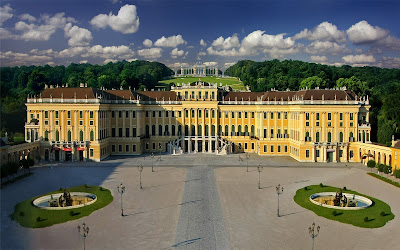

































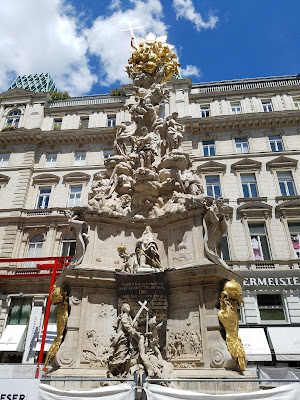







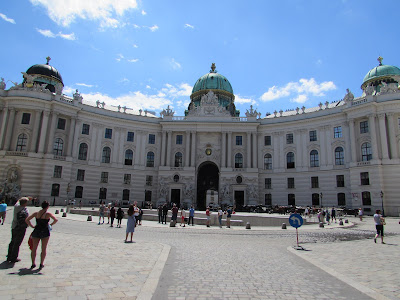










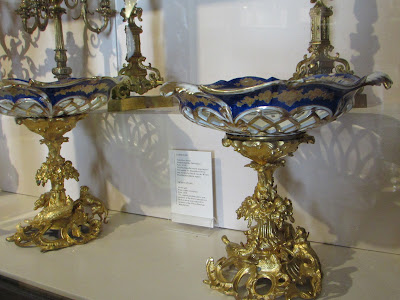


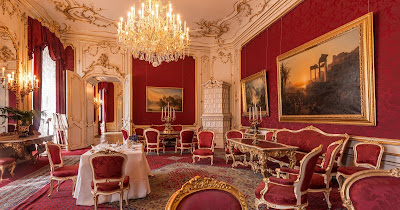













No comments:
Post a Comment